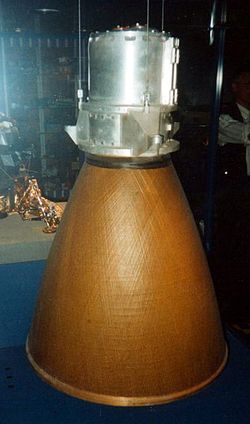 Apollo LM ascent engine | |
| Country of origin | United States |
|---|---|
| Date | 1964–72 |
| Manufacturer | Bell Aircraft / Rocketdyne |
| Application | Lunar Ascent Stage/Spacecraft propulsion |
| Predecessor | Bell 8247 |
| Successor | RS-18 |
| Status | Retired |
| Liquid-fuel engine | |
| Propellant | N 2O 4 / Aerozine 50 |
| Mixture ratio | 1.6 |
| Cycle | Pressure-fed |
| Pumps | None |
| Configuration | |
| Chamber | 1 |
| Nozzle ratio | 46 |
| Performance | |
| Thrust, vacuum | 3,500 pounds-force (16 kN) |
| Thrust-to-weight ratio | 16.7 (weight on Earth) |
| Chamber pressure | 120 psia |
| Specific impulse, vacuum | 311 seconds (3.05 km/s) |
| Burn time | 465 seconds |
| Restarts | Designed for 2 restarts |
| Dimensions | |
| Length | 51 inches (130 cm) |
| Diameter | 31 inches (79 cm) |
| Dry mass | 210 pounds (95 kg) |
| Used in | |
| Lunar module as ascent engine | |
| References | |
| References | [1] |
The ascent propulsion system (APS) or lunar module ascent engine (LMAE) is a fixed-thrust hypergolic rocket engine developed by Bell Aerosystems for use in the Apollo Lunar Module ascent stage. It used Aerozine 50 fuel, and N
2O
4 oxidizer. Rocketdyne provided the injector system, at the request of NASA, when Bell could not solve combustion instability problems.[2]
- ^ Bartlett, W.; Kirkland, Z. D.; Polifka, R. W.; Smithson, J. C.; Spencer, G. L. (February 7, 1966). Apollo spacecraft liquid primary propulsion systems (PDF) (Technical report). Houston, TX: NASA, Manned Spacecraft Center. pp. 8–9. 70N35721. Archived (PDF) from the original on August 23, 2022. Retrieved August 23, 2022.
- ^ Cite error: The named reference
LMAEwas invoked but never defined (see the help page).